B0041VYHGW EBOK (70 page)
Authors: David Bordwell,Kristin Thompson

[I] divided the mm range of the zoom lens in half and starting from the middle I recorded changes in mm positions…. The camera was not moved at all. The zoom lens was not moved during recording either. Each frame was recorded individually as a still. Four frames to each position. To give an example: I shot the first four frames at 50mm. The next four frames I shot at 55mm. And then, for a certain duration, approximately 60 feet, I went back and forth, four frames at 50mm, four frames at 55mm; four frames at 50mm, four frames at 55mm; etc…. for about 60 feet. Then I went to 45–60 [mm] and did the same for about 60 feet. Then to 40–65, and so on.
The resulting film presents an image whose perspective relations pulsate rhythmically—first with little difference in size and scale, but gradually with greater tension between a telephoto image and a wide-angle image
(
5.35
).
In a sense,
Serene Velocity
takes as its subject the effect of focal length on perspective.
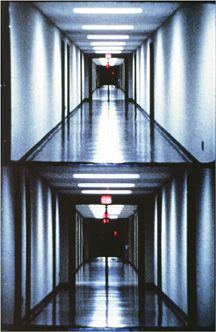
5.35 In
Serene Velocity,
telephoto shots of a hallway are juxtaposed to wide-angle shots taken from the same spot.
Focal length not only affects how shape and scale are magnified or distorted. It also affects the lens’s
depth of field
—the range of distances before the lens within which objects can be photographed in sharp
focus
. A lens with a depth of field of 10 feet to infinity will render any object in that range clearly, but the sharpness of the image will decrease when the object moves closer to the lens (say, to 4 feet). All other things being equal, a short-focal-length (wide-angle) lens has a relatively greater depth of field than does a long-focal-length (telephoto) lens.
Depth of field should not be confused with the concept of deep space, discussed in
Chapter 4
.
Deep space
is a term for the way the filmmaker has staged the action on several different planes,
regardless of whether all of these planes are in focus.
In the case of
Our Hospitality,
those planes usually are in sharp focus, but in other films, not every plane of deep space is in focus. In this shot from
Simple Men
(
5.36
),
we can see three planes of depth, but deep focus isn’t used. The robber and the security guard she holds at pistol point in the middle ground are in focus. But the yellow railing forming a distinct foreground plane is out of focus. In the distant background, visible between the rails, stands the female robber’s partner. He’s out of focus, too. The example shows that deep space is a property of mise-en-scene, the techniques that affect what is placed in front of the camera. Depth of field depends on the camera itself, with the lens determining what layers of the mise-en-scene are in focus.
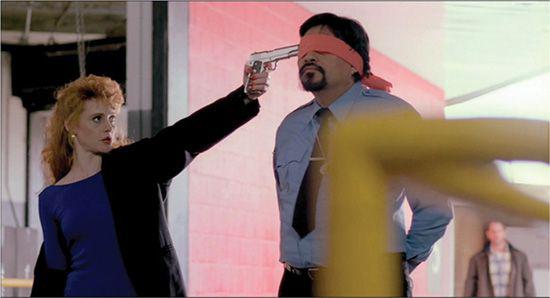
5.36 In the first shot of
Simple Men,
the foreground railing and the man in the distance are out of focus, emphasizing the drama in focus in the middle ground.
As the
Simple Men
example suggests, selective focus is often used to call attention to the main action and to deemphasize less significant parts of the surroundings. Often this involves centering the main character in the foreground and throwing the background out of focus
(
5.37
).
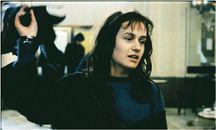
5.37 Agnès Varda’s
Vagabonde (Sans toi ni loi).
If depth of field controls perspective relations by determining which planes will be in focus, what choices are open to the filmmaker? He or she may opt for what is usually called
selective focus
—choosing to focus on only one plane and letting the other planes blur. This is what director Hal Hurtley does in the
Simple Men
example. Selective focus typically draws the viewer’s attention to the main character or object (
5.37
). The technique can be used for a more abstract compositional effect as well
(
5.38
).
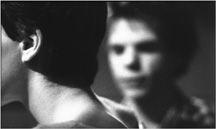
5.38 Leos Carax’s
Boy Meets Girl.
In Hollywood during the 1940s, partly due to the influence of
Citizen Kane,
filmmakers began using faster film, shorter-focal-length lenses, and more intense lighting to yield a greater depth of field. The contract-signing scene from
Citizen Kane
(
5.39
)
offers a famous example. This practice came to be called
deep focus
.
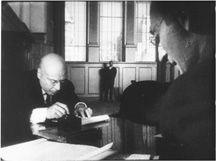
5.39 In
Citizen Kane,
from one plane near the lens (Bernstein’s head), through several planes in the middle ground, to the wall far in the distance, everything is in sharp focus.
Deep-focus cinematography became a major stylistic option in the 1940s and 1950s. A typical usage is illustrated in
5.40
. The technique was even imitated in animated cartoons (
4.133
, from Chuck Jones’s
One Froggy Evening
). During the 1970s and 1980s, deep-focus cinematography was revived in Steven Spielberg’s work, notably
Jaws
and
Close Encounters of the Third Kind,
and in the films of Brian De Palma
(
5.41
).
Today, extreme deep-focus effects are common in digital video
(
5.42
).
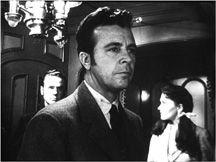
5.40 Anthony Mann’s
The Tall Target.
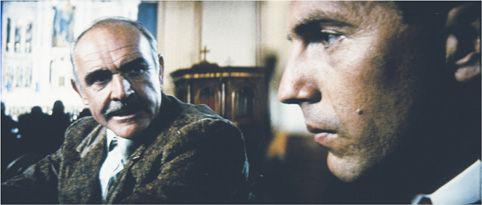
5.41 In
The Untouchables,
a conversation scene is played in the foreground while setting and distant figures are also kept in focus.
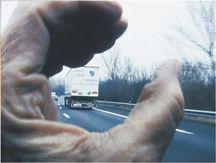
5.42 The small size of the chip in a digital video camera yields extreme depth of field. If this shot, from Agnès Varda’s
The Gleaners and I,
had been made on film, either Varda’s hand or the truck would have been far more out of focus.